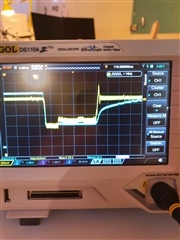Hello Devzone,
I'm designing a custom board solution that drives a motor using a nRF52832. The board is powered with 4 x AAA batteries and a 2.5V LDO (STLQ50C25R) is used to power the nRF52.
During high load with decently charged batteries the batteries voltage drops down to low voltages that the LDO can't regulate but which is still inside specification for the nRF52. In this example Vin and Vdd drops to around ~2.1V during load.
When the load decreases we see a 500-600mV spike on Vdd from the 2.1V level. This should easily cause an power on reset according to the product specification.
"A step increase in supply voltage of 300 mV or more, with rise time of 300 ms or less, within the valid supply range, may result in a system reset." Product Specification 1.4 page 82.
On 10x+ tested boards over many samples we have not seen the reset. The question is why have we not seen this?
The quick fix that I have available right now for this batch of boards would be to switch the LDO to one that outputs 1.8V (STLQ50C18R) but that feels a bit on the edge of the Vdd specification so I would like to keep the 2.5V one if possible.
Attaching scope below. Not the best quality but it should help to understand the picture.
Yellow trace is the VDD. It starts at 2.5V and goes down to roughly 2.1V. Blue trace is battery voltage. It starts at 5.2V and goes down to roughly 2.1V as well. The time from the Vdd decrease until it increases is roughly 20ms.

Thanks for the help!

